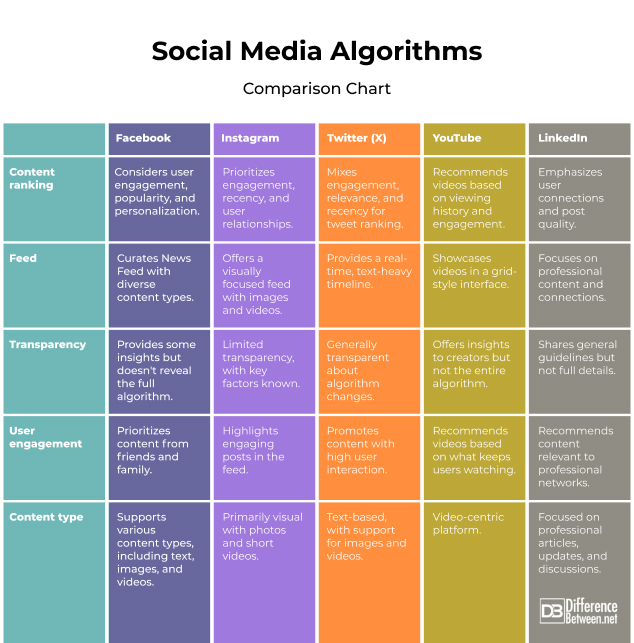Difference Between Social Media Algorithms
Social media has become an integral part of our lives, connecting people across boundaries and providing a platform for sharing ideas, opinions, and content. But have you ever wondered how these platforms work and how they decide what content to show you? It’s all about algorithms. Most of you have no idea what algorithms are or how they work.
Never mind! Social media algorithms aren’t as mysterious as you might think. In this article, we’ll break down everything you need to know about algorithms like Facebook, Instagram, Twitter (X), etc.

Understanding different social media algorithms
The algorithms used by social media platforms are constantly evolving, but here are some of the most common ones:
Facebook uses a machine-learning algorithm to curate users’ News Feeds. It prioritizes posts that are likely to be engaging for the user based on factors such as the user’s past interactions, the content of the post, and the time of day the post is published. Posts from friends and family are given priority, followed by content from groups and pages a user interacts with frequently.
Instagram focuses on showing users the most engaging content. It uses a set of processes to figure out what you like. Then, it uses this info to show you more of the stuff you find interesting and engaging. It’s important to note that there isn’t just one all-powerful algorithm, despite what some people might think.
Twitter (X)
Twitter (X) prioritizes the latest and most relevant content, regardless of who posted it. However, it does take into account your past interactions, such as which accounts you follow and which tweets you have liked or retweeted. It takes into account your interests, engagement patterns, and recency of your tweets.
YouTube
YouTube recommends videos to users based on their watch history, the videos they have liked or commented on, and the videos that other users with similar interests have watched. It aims to keep users engaged with the platform by showing them content they’re likely to find interesting. Surprisingly, YouTube’s recommendation algorithm drives 70 percent of what people watch.
LinkedIn’s algorithm is a clever system that sorts through a massive user base of 810 million members. It analyzes various factors to determine what shows up in your feed, aiming to keep it engaging and relevant.
Now, social media platforms like Facebook, Twitter, Instagram, etc. use different ranking factors, such as:
- Engagement: At the heart of social media algorithms is engagement. This means that the more likes, comments, and shares a post gets, the more likely it is to reach a wider audience.
- Recency: Freshness matters too. Recent posts tend to pop up higher in your feed because, let’s face it, you want to see what’s happening now, not yesterday’s news.
- Relevance: Ever noticed how your feed seems to know your interests? That’s because algorithms strive to serve content that’s relevant to you. They do this by analyzing your past interactions, like the pages you follow and posts you’ve liked or commented on.
- Relationship: Your connections matter. The algorithm takes into account your relationships with the people or accounts you follow. Posts from your close friends and family are given a front-row seat in your feed.
- Popularity: Content that’s been liked and shared by many users has a better shot at reaching a larger audience. It’s like the algorithm saying, “Hey, a lot of people are into this, maybe you will be too!”
Social Media Algorithms: Comparison Chart

Summary
These algorithms are the gears that power your social media experience, making sure you see what matters most to you. It’s all about keeping your feed fresh, engaging, and relevant. So, next time you scroll through your social media, remember that it’s these friendly algorithms that make it all happen! Understanding these differences can help you tailor your strategies for each platform.
FAQs
Are all social media algorithms the same?
No, social media algorithms are not the same. Each platform has its own algorithm that is designed to show users the content that they are most likely to engage with.
What algorithms are used in social media?
Common types include content recommendation algorithms, feed ranking algorithms, and content categorization algorithms. These algorithms aim to determine what content to show to users, when to show it, and how to personalize the user experience.
What is the role of algorithms in social media?
Algorithms play a vital role in social media by personalizing the user experience and showing users the content that they are most likely to be interested in. Algorithms analyze user behavior, such as likes, comments, and shares, to curate and prioritize content in a user’s feed.
How can you outsmart social media algorithms?
Outsmarting social media algorithms can be challenging, but some general strategies include:
- Creating and posting high-quality content
- Identifying your audience
- Using relevant keywords and hashtags
- Encouraging meaningful interactions (likes, comments, shares, etc.)
Do Instagram and TikTok have the same algorithm?
Instagram’s algorithm is more focused on showing users content from people they follow, while TikTok’s algorithm is more focused on showing users popular content, regardless of who posted it.
Is Facebook and Instagram algorithm the same?
Facebook and Instagram do not use the same algorithm, although they share some similarities. Instagram is owned by Facebook, so they have some overlapping features. For example, both algorithms prioritize posts that have received a lot of engagement. However, their algorithms prioritize content differently.
- Difference Between Caucus and Primary - June 18, 2024
- Difference Between PPO and POS - May 30, 2024
- Difference Between RFID and NFC - May 28, 2024
Search DifferenceBetween.net :
Leave a Response
References :
[0]The Impact of Social Media Algorithms on Organic Reach. Mayfair Digital Agency, 2021.
[1]Barnhart, Brent. “Everything You Need to Know About Social Media Algorithms.” Sprout Social, 26 Mar. 2021, sproutsocial.com/insights/social-media-algorithms/.
[2]Verma, Monika. “Understanding Social Media Algorithm [2023 Complete Guide].” SocialPilot, 17 Apr. 2023, www.socialpilot.co/blog/social-media-algorithm.
[3]Hughes, Josiah. “How the Twitter Algorithm Works [2023 GUIDE].” Hootsuite Blog, 14 Dec. 2022, blog.hootsuite.com/twitter-algorithm/.
[4]Kiros, Hana. “Hated That Video? YouTube’s Algorithm Might Push You Another Just Like It.” MIT Technology Review, 20 Sept. 2022, www.technologyreview.com/2022/09/20/1059709/youtube-algorithm-recommendations/.
[5]McLachlan, Stacey and Paige Cooper. “How the YouTube Algorithm Works in 2023: The Complete Guide.” Hootsuite Blog, 18 Apr. 2023, blog.hootsuite.com/how-the-youtube-algorithm-works/.
[6]McLachlan, Stacey. “LinkedIn Algorithm: How it Works in 2023.” Hootsuite Blog, 30 June 2022, blog.hootsuite.com/how-the-linkedin-algorithm-works-hacks/.
[7]Image credit: https://www.canva.com/photos/MADp_FjOECk-social-media-and-people-network-technology-concept/
